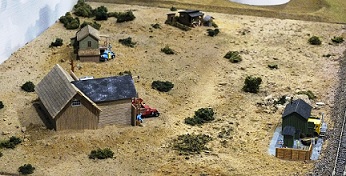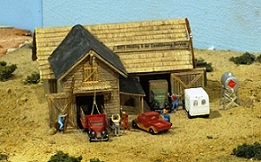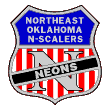Module Building Specifications
Updated 7/20/11
All Club modules are built to N-Trak standards with
the following exceptions and additional considerations:
- It is suggested, but not required, that module frames be built following the NEONS module construction specs with integral, latching, fold-up legs, frame supports and a laminated skyboard.
- No mountain line.
- All turnouts on the red, yellow and blue lines should be PECO long radius, with
the through line going down the straight leg rather than down the diverging leg
of the turnout.

- All tracks must be in gauge and should be code 80 where the joiner tracks connect. All rail joiners should be soldered to the tracks (except those used for attaching joiner tracks.)
- Since we like to run long trains, tight and/or, ogee curves are to be avoided. Where there are curves, the longer the radius, the better.
- Power bus lines should be as per revised N-Trak recommended practices, i.e. red, yellow and blue busses should each be a continuous piece of 12 gauge stranded zip cord with a 16 gauge pigtail soldered to the bus to provide power to the module. Each bus line should extend at least 1’ beyond each end of the module. Bus line end plugs must have Anderson PP30 30 amp Powerpole connectors soldered to each end. All wiring should conform to normal practices of attaching the red/ribbed wire to the front rail and the black or white/non-ribbed wire to back rail. 18 gauge feeder wires should be attached to the rails every two feet.
- A 15-amp, 3-conductor, UL approved power strip with integral cord and plug should be attached to the belly of the module. The plug end of the cord should extend two feet beyond the end of the module.
- All wires that are needed to inter-connect modules should be secured with Velcro straps so that no wires hang down where they can be damaged during transportation. All other wires should be permanently laced and secured against the belly of the module. Nip the tail off of lacing zip ties.
- Main line track height must be adjustable from 39'' to 41".
- Sky boards should rise 12" from datum (the top of the module surface before roadbed and track) and be painted flat Main Line Blue (Wal-Mart #3155.) The club has cloud stencils available.
- It is recommended, but not required, that skyboards be made by laminating ⅛” Masonite onto ⅜” plywood. The laminated board is sturdier and less likely to warp and the smooth surface of the Masonite looks much better than grainy wood.
- The module front fascia board should be painted semi-gloss Industrial Brown (Wal-Mart #96144.)
- A 6¾” wide, 3/16” thick, clear Plexiglas shield should be attached along the front fascia board, extending 4¼” above datum. This serves two purposes, to discourage little fingers from reaching in and touching things and to protect rolling stock from a potentially fatal fall if a derailment occurs.
- Homosote plugs (½” x ½” x 2”) should be inserted into the fascia board at least every 2’ so skirting can be pinned on easily. The horizontal centerline for the plugs is 3¼” below datum.
- Prior to ballasting, rails should be painted flat black.
- Red and Yellow Main lines and their associated passing tracks and sidings should be ballasted with NEONS main line blend. (Pre-mixed NEONS ballast is sold at Challenger N-Scale Hobbies.)
- Blue Branch line and all other tracks should be ballasted with NEONS branch line blend.
- It is recommended, but not required, that two 3¼” x 3¼” x 1/8” Masonite clamp pads be glued to each end of the module to minimize damage to the fascia boards by the C-clamps.
- All modules must have scenery completed prior to exhibition, i.e. no bare plywood or foam showing.
| NEONS MAIN LINE BALLAST | NEONS BRANCH LINE BALLAST |
|---|---|
| 1 part Woodland Scenics B-73 (Buff) | 3 parts Woodland Scenics B-71 (Dark Brown) |
| 1 part Woodland Scenics B-74 (Lt. Gray) | 2 parts Woodland Scenics B-75 (Gray) |
| 1 part Woodland Scenics B-75 (Gray) | 1 part Woodland Scenics B-76 (Cinders) |



